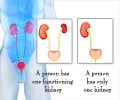
Kidney disease is usually caused by high blood pressure and diabetes and this can also lead to end-stage renal failure.
Since, First Nations people develop diabetes when they are younger, they could also become victims of renal failure.
"Among First Nations adults, Type 2 diabetes is increasingly occurring during younger decades of life. Among First Nations children, the prevalence of diabetes tripled between 1980 and 2005, and the offspring of these individuals are in turn experiencing an even higher risk of childhood Type 2 diabetes,” study authors said.
"Without substantial improvements in the prevention and treatment of this disease, this pattern will likely translate into increasing numbers of First Nations people with diabetes-related end-stage renal disease and possibly other chronic diabetic complications."
Advertisement













